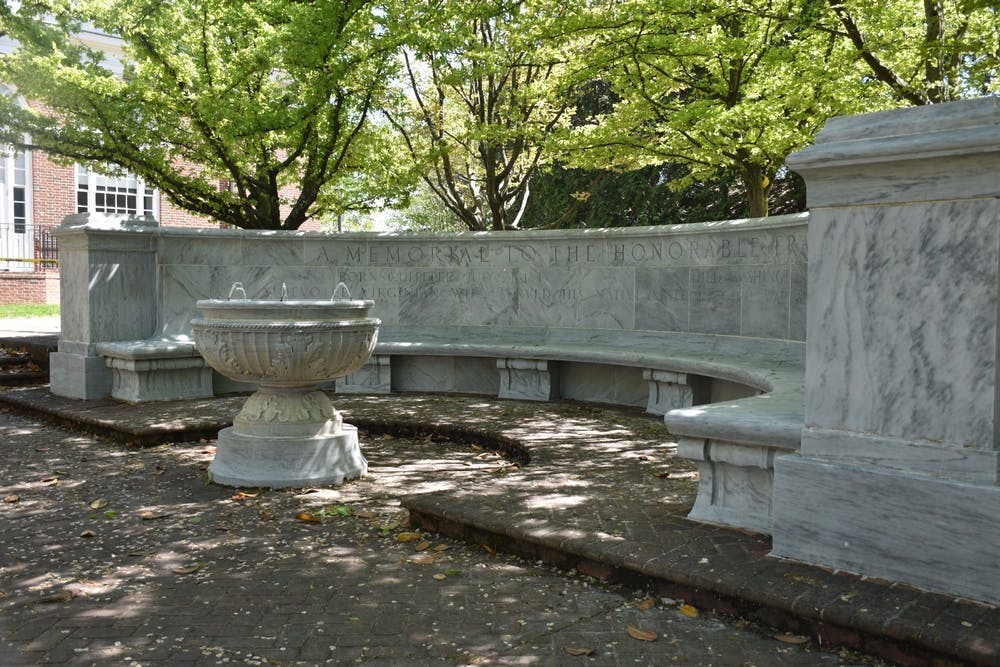中文版请点击此处
Recommendations by the Committee on Naming and Memorials were supported by the Board of Visitors on April 13. The recommendations include digitally contextualizing statutes and memorials at the University to create a “digital historical stratigraphy.” This aims to compile a complete, “informed perspective” of monuments for students, visitors and community members. University President Jim Ryan said he “couldn’t be happier” about this recommendation, with the committee ruling digital contextualization the most “practicable option.” According to the decision, digital contextualization of the historic landscape allows more detail and flexibility given the limited space around Grounds that physical markers would intrude upon.
But we could be happier, Ryan — in a society structured on racism, dismantling white supremacy calls us to think beyond practicable options. Digital contextualization is inadequate, and the University must ensure student demands are met, Confederate monuments are removed and the Board doesn’t go back on its word to eradicate symbols of hate on Grounds.
The committee recommended professional historians, students, Charlottesville residents and alumni work together on digital contextualization through a working group established by Ryan. This would include creating QR codes to access the history of statues around Grounds, such as the Thomas Jefferson statue in front of the Rotunda. This would eventually develop into a “walking tour of statues and memorials.” Though the committee noted the tour’s narrative would cover the full history of the commission, funding, construction and “informed treatment” of the artist for all memorials and statues, it isn’t enough.
Prof. Jalane Schmidt and Jefferson School Executive Director Andrea Douglass demonstrate the power of technology in contextualization with the Marked by These Monuments audio tour of Charlottesville. However, this resource is a tool to push for removal of monuments to white supremacy. It was never meant to be the solution. A walking tour designed through digital contextualization without further action would allow the true history of white supremacy around Grounds to remain hidden.
The contextualization of statutes — such as those of Thomas Jefferson — should be as in your face as the physical monuments are. Placing QR codes on statues and memorials rather than physical contextualization is performative activism of the highest degree. This method of contextualization is also inherently inaccessible, as users would need a smartphone in order to access the information provided. It reinforces the University's pattern of hiding — rather than taking accountability for — its history and its tendency to push the onus of learning onto students. If the historic landscape made room for statues that perpetuate a racist narrative, it must now dedicate room for markers to contextualize them. In addition to this, there are some statues and memorials that even contextualization is not enough. All Confederate statutes — such as the one in the cemetery — need to be removed, just as other forms of dedicated to or memorialization of the Confederacy must be rededicated or removed as well.
The Board will meet in June regarding the Frank Hume Memorial Fountain — often referred to as the Whispering Wall — following Wednesday’s community listening session with the Naming and Memorials Committee. While the Board voted to remove or rededicate the wall in September, the fate of the monument remains in question. With organizers such as the Minority Rights Coalition adamantly calling for its removal, we believe the answer is clear — the Hume Memorial must come down.
Written across the Hume Memorial Fountain are the words “A Memorial To The Honorable Frank Hume — A Devoted Virginian Who Served His Native State In Civil War And Legislative Hall.” The word “honorable” should not be used to describe a man who fought for the Confederacy and protection of slavery and held countless events romanticizing the Confederate efforts after the Civil War’s end. This monument is a disgusting romanticization of the nation’s past located in a high-traffic area on Grounds and even shown to prospective students during many tours of the University. Considering Hume had no ties to the University, there is no question that the fountain is yet another vestige of the institution’s historic glorification of white supremacy. We urge the University to do more than just rededicate the Whispering Wall — remove the memorial and trauma its continued presence signifies for marginalized students.
The University cannot continue to perpetuate and hide its racist history. The Board must listen to community demands and remove the Frank Hume Memorial Fountain. Students are forced to walk past these memorials every day — a slab of stone should never take priority over the mental wellbeing and sense of belonging of those who walk through Grounds.
The Cavalier Daily Editorial Board is composed of the Executive Editor, the Editor-in-Chief, the two Opinion Editors, their Senior Associate and an Opinion Columnist. The board can be reached at eb@cavalierdaily.com.







